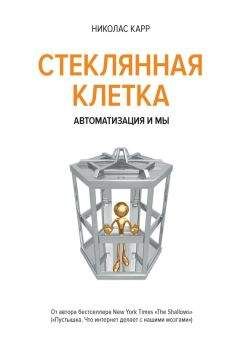21. См., например: Jan M. Wiener et al. Maladaptive Bias for Extrahippocampal Navigation Strategies in Aging Humans // Journal of Neuroscience 33, 2013. № 14. Р. 6012–6017.
22. См., например: A. T. Du et al. Magnetic Resonance Imaging of the Entorhinal Cortex and Hippocampus in Mild Cognitive Impairment and Alzheimer’s Disease // Journal of Neurology, Neurosurgery and Psychiatry 71, 2001. Р. 441–447.
23. Kyoko Konishi and Véronique D. Bohbot. Spatial Navigational Strategies Correlate with Gray Matter in the Hippocampus of Healthy Older Adults Tested in a Virtual Maze // Frontiers in Aging Neuroscience 5, 2013. Р. 1–8.
24 Электронное письмо Вероники Бобо автору от 4 июня 2010 года.
25. Цитируется по статье: Alex Hutchinson. Global Impositioning Systems // Walrus, 2009. November.
26. Kyle VanHemert. 4 Reasons Why Apple’s iBeacon Is About to Disrupt Interaction Design // Wired, 2013. December 11. www.wired.com/ UPL: http://www. design/2013/12/4-use-cases-for-ibeacon-the-most-exciting-tech-youhavent-heard-of/.
27. Цитируется по книге: Fallows. Places You’ll Go.
28. Damon Lavrinc. Mercedes Is Testing Google Glass Integration, and It Actually Works // Wired, 2013. August 15. UPL: http://www. wired.com/autopia/2013/08/google-glass-mercedes-benz/.
29. William J. Mitchell. Foreword. В книге: Yehuda E. Kalay. Architecture’s New Media: Principles, Theories, and Methods of Computer-Aided Design Cambridge, Mass.: MIT Press, 2004. xi.
30. Anonymous. Interviews: Renzo Piano // Architectural Record, 2001. October. UPL: http://www. archrecord.construction.com/people/interviews/archives/0110piano.asp.
31. Цитируется по: Gavin Mortimer. The Longest Night. N. Y.: Penguin, 2005. Р. 319.
32. Dino Marcantonio. Architectural Quackery at Its Finest: Parametricism //Marcantonio Architects Blog, 2010. May 8.UPL: http://www. blog.marcantonioarchitects.com/architectural-quackery-at-its-finest-parametricism/.
33. Paul Goldberger. Digital Dreams // New Yorker, 2001. March 12.
34. Patrik Schumacher. Parametricism as Style – Parametricist Manifesto // Patrik Schumacher’s blog, 2008. UPL: http://www. patrikschumacher.com/Texts/Parametricism%20as%20Style.htm.
35. Anonymous. Interviews Renzo Piano.
36. Witold Rybczynski. Think before You Build // Slate, 2011. March 30. UPL: http://www.slate.com/articles/arts/architecture/2011/03/think_before_you_build.html.
37. Цитируется по: Bryan Lawson. Design in Mind. Oxford, U.K.: Architectural Press, 1994. Р. 66.
38. Michael Graves. Architecture and the Lost Art of Drawing // New YorkTimes, 2012. September 2.
39. D. A. Schцn. Designing as Reflective Conversation with the Materials of a Design Situation // Knowledge-Based Systems 5, 1992. № 1. Р. 3–14. См. также книгу Шёна: The Reflective Practitioner: How Professionals Think in Action. N. Y.: Basic Books, 1983. Р. 157–159.
40. Michael Graves. Architecture and the Lost Art of Drawing. См. также: Masaki Suwa et al. Macroscopic Analysis of Design Processes Based on a Scheme for Coding Designers’ Cognitive Actions // Design Studies 19, 1998. Р. 455–483.
41. Nigel Cross. Designerly Ways of Knowing. Basel: Birkhдuser, 2007. 58.
42. Scho#n. Designing as Reflective Conversation.
43. Там же.
44. Joachim Walther et al. Avoiding the Potential Negative Influence of CAD Tools on the Formation of Students’ Creativity. В книге: Proceedings of the 2007 AaeE Conference. Melbourne, Australia, 2007. December. UPL: http://www. 2.cs.mu.oz.au/aaee2007/papers/paper_40.pdf.
45. Graves. Architecture and the Lost Art of Drawing.
46. Juhani Pallasmaa. The Thinking Hand: Existential and Embodied Wisdom in Architecture. Chichester, U.K.: Wiley, 2009. Р. 96–97.
47. Интервью Мида автору от 23 июля 2013 года.
48. Jacob Brillhart. Drawing towards a More Creative Architecture: Mediating between the Digital and the Analog, Статья была представлена на ежегодной конференции Ассоциации университетских кафедр архитектуры в Монреале 5 марта 2011 года.
49. Matthew B. Crawford. Shop Class as Soulcraft: An Inquiry into the Value of Work. N.Y.: Penguin, 2009. Р. 164.
50. Там же. Р. 161.
51. John Dewey. Essays in Experimental Logic. Chicago: University of Chicago Press, 1916. Р. 13–14.
52. Matthew D. Lieberman. The Mind-Body Illusion // Psychology Today, 2012. May 17. UPL: http://www. psychologytoday.com/blog/social-brain-social-mind/201205/the-mind-body-illusion. См. также: Matthew D. Lieberman. What Makes Big Ideas Sticky? / What’s Next? Dispatches on the Future of Science / Ed. Max Brockman. N. Y.: Vintage. 2009. Р. 90–103.
53. Andy Clark. Embodied Cognition (video). University of Edinburgh: Research in a Nutshell. UPL: http://www. undated, nutshell-videos.ed.ac.uk/andy-clarkembodied-cognition.
54. Tim Gollisch and Markus Meister. Eye Smarter than Scientists Believed: Neural Computations in Circuits of the Retina // Neuron 65, 2010. January 28. Р. 150–164.
55. См.: Vittorio Gallese and George Lakoff. The Brain’s Concepts: The Role of the Sensory-Motor System in Conceptual Knowledge // Cognitive Neuropsychology 22, 2005. № ¾. Р. 455–479; Lawrence W. Barsalou. Grounded Cognition // Annual Review of Psychology 59, 2008. Р. 617–645.
56. Andy Clark. Embodied Cognition.
57. Shaun Gallagher. How the Body Shapes the Mind. Oxford, U.K.: Oxford University Press, 2005. Р. 247.
58. Andy Clark. Natural-Born Cyborgs: Minds, Technologies, and the Future of Human Intelligence. N. Y.: Oxford University Press, 2003. Р. 4.
59. Цитируется по книге: Fallows. Places You’ll Go.
Глава седьмая. Автоматизация для людей1. Kevin Kelly. Better than Human: Why Robots Will – and Must – Take Our Jobs // Wired, 2013. January.
2. Jay Yarow. Human Driver Crashes Google’s Self Driving Car // Business Insider, 2011. August 5. UPL: http://www. businessinsider.com/googles-self-driving-carsget-in-their-first-accident-2011–8.
3. Andy Kessler. Professors Are About to Get an Online Education // Wall Street Journal. 2013. June 3.
4. Vinod Khosla. Do We Need Doctors or Algorithms? // TechCrunch, 2012. January 10. UPL: http://www.techcrunch.com/2012/01/10/doctors-or-algorithms.
5. Gerald Traufetter. The Computer vs. the Captain: Will Increasing Automation Make Jets Less Safe? // Spiegel Online, 2009. July 31. UPL: http://www. Spiegel de/international/world/the-computer-vs-the-captain-will-increasing-automation-make-jets-less-safe-a-639298.html.
6. См.: Adam Fisher. Inside Google’s Quest to Popularize Self-Driving Cars // Popular Science, 2013. October.
7. Tosha B. Weeterneck et al. Factors Contributing to an Increase in Duplicate Medication Order Errors after CPOE Implementation //Journal of the American Medical Informatics Association 18, 2011. Р. 774–782.
8. Sergey V. Buldyrev et al. Catastrophic Cascade of Failures in Interdependent Networks.// Nature, 464. 2010. April 15. Р. 1025–1028. См. также: Alessandro Vespignani. The Fragility of Interdependency // Nature 464, 2010. April 15. Р. 984–985.
9. Nancy G. Leveson. Engineering a Safer World: Systems Thinking Applied to Safety. Cambridge, Mass.: MIT Press, 2011. 8–9.
10. Lisanne Bainbridge. Ironies of Automation // Automatica 19, 1983. № 6. Р. 775–779.
11. Обзор исследований, посвященных бдительности, включая работы, выполненные во время Второй мировой войны, см.: D. R. Davies and R. Parasuraman // The Psychology of Vigilance. London: Academic Press, 1982.
12. Bainbridge. Ironies of Automation.
13. См. Magdalen Galley. Ergonomics – Where Have We Been and Where Are We Going. UPL: http://www. undated speech, taylor.it/meg/papers/50 %20Years%20 of%20Ergonomics.pdf;
Nicolas Marmaras et al. Ergonomic Design in Ancient Greece // Applied Ergonomics 30, 1999. № 4. Р. 361–368.
14. David Meister. The History of Human Factors and Ergonomics. Mahwah, N.J.: Lawrence Erlbaum Associates, 1999. Р. 209, 359.
15. Leo Marx. Does Improved Technology Mean Progress? // Technology Review. 1987. January.
16. Donald A. Norman. Things That Make Us Smart: Defending Human Attributes in the Age of the Machine. N. Y.: Perseus, 1993. xi.
17. Norbert Wiener. I Am a Mathematician. Cambridge, Mass.: MIT Press, 1956. Р. 305.
18. Nadine Sarter et al. Automation Surprises. / Handbook of Human Factors and Ergonomics / Ed. Gavriel Salvendy. 2nd ed. N. Y.: Wiley, 1997.
19. Там же.
20. John D. Lee. Human Factors and Ergonomics in Automation Design / Handbook of Human Factors and Ergonomics / Ed. Gavriel Salvendy. 3rd ed. Hoboken, N.J.: Wiley, 2006. Р. 1571.
21. Еще об ориентированной на человека автоматизации см.: Charles E. Billings. Aviation Automation: The Search for a Human-Centered Approach. Mahwah, N.J.: Lawrence Erlbaum Associates, 1997; Raja Parasuraman et al. A Model for Types and Levels of Human Interaction with Automation // IEEE Transactions on Systems, Man, and Cybernetics 30, 2000. № 3. Р. 286–297.
22. David B. Kaber et al. On the Design of Adaptive Automation for Complex Systems // International Journal of Cognitive Ergonomics 5, 2001. № 1. Р. 37–57.
23. Mark W. Scerbo. Adaptive Automation В книге: Neuroergonomics: The Brain at Work / Eds. Raja Parasuraman and Matthew Rizzo. N. Y.: Oxford University Press, 2007. Р. 239–252. См. также: Mark St. John et al. Overview of the DARPA Augmented Cognition Technical Integration Experiment // International Journal of Human-Computer Interaction 17, 2004. № 2. Р. 131–149.
24. Lee. Human Factors and Ergonomics.
25. Интервью Раджа Парасурамана автору от 18 декабря 2011 года.
26. Lee. Human Factors and Ergonomics.
27. Интервью Бена Трейнела автору от 13 июня 2013 года.
28. Mark D. Gross and Ellen Yi-Luen Do. Ambiguous Intentions: A Paperlike Interface for Creative Design // Proceedings of the ACM Symposium on User Interface Software and Technology. N. Y.: ACM, 1996. Р. 183–192.
29. Julie Dorsey et al. The Mental Canvas: A Tool for Conceptual Architectural Design and Analysis // Proceedings of the Pacific Conference on Computer Graphics and Applications, 2007. Р. 201–210.
30. William Langewiesche. Fly by Wire: The Geese, the Glide, the “Miracle” on the Hudson. N. Y.: Farrar, Straus & Giroux, 2009. Р. 102.
31. Lee. Human Factors and Ergonomics.
32. CBS News. Faulty Data Misled Pilots in ’09 Air France Crash. 2012. July 5. UPL: http://www. cbsnews.com/8301–505263_162–57466644/faulty-datamisledpilots-in-09-air-france-crash/.
33. Langewiesche. Fly by Wire. Р. 109.
34. Federal Aviation Administration. NextGen Air Traffic Control/Technical Operations Human Factors (Controller Efficiency & Air Ground Integration) Research and Development Plan. 2011. version one, April.
35. Nathaniel Popper. Bank Gains by Putting Brakes on Traders // New York Times, 2013. June 26.
36. Thomas P. Hughes. Technological Momentum. В книге: Does Technology Drive History? The Dilemma of Technological Determinism / Eds. Merritt Roe Smith and Leo Marx. Cambridge, Mass.: MIT Press, 1994. Р. 101–113.
37. Gordon Baxter and John Cartlidge. Flying by the Seat of Their Pants: What Can High Frequency Trading Learn from Aviation? / ATACCS-2013: Proceedings of the 3rd International Conference on Application and Theory of Automation in Command and Control Systems / Eds. G. Brat et al. N. Y.: ACM, 2013. Р. 64–73.
38. David F. Noble. Forces of Production: A Social History of Industrial Automation. N.Y.: Alfred A. Knopf, 1984. Р. 144–145.
39. Там же. P. 94.
40. Цитируется по: Noble. Forces of Production. Р. 94.
41. Там же. P. 326.
42. Дайсон высказывает это утверждение в снятом в 1981 году документальном фильме. The Day after Trinity. Цитируется по статье: Bill Joy. Why the Future Doesn’t Need Us // Wired, 2000. April.
43. Matt Richtel. A Silicon Valley School That Doesn’t Compute // New York Times, 2011. October 23.
Интерлюдия. Грабитель могил1. Peter Merholz. Frictionless’ as an Alternative to ‘Simplicity’ in Design,” Adaptive Path (blog), 2010. July 21. UPL: http://www. adaptivepath.com/ideas/friction-asan-alternative-to-simplicity-in-design.
2. David J. Hill. Exclusive Interview with Ray Kurzweil on Future AI Project at Google // SingularityHUB, 2013. January 10. UPL: http://www. singularityhub.com/2013/01/10/exclusive-interview-with-ray-kurzweil-on-future-aiproject-at-google/.
Глава восьмая. Ваш внутренний робот1. Азимовские правила поведения роботов (три правила, намертво встроенные в позитронный мозг роботов) впервые появились в опубликованном в 1942 году рассказе «Хоровод», включенном в сборник «Я – робот». N. Y.: Bantam, 2004. Р. 37.





